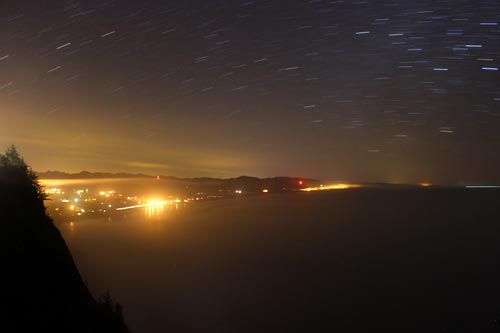Remnants of Halley's Comet Over Oregon, the Coast This Month
Published 05/03/2016 at 7:11 PM PDT
By Oregon Coast Beach Connection staff

(Oregon Coast) – The northern hemisphere is getting quite the interstellar show right now, and it will start its peak on Thursday for Oregon, Portland and the coastline with the spectacle known as the Eta Aquarids. This particular meteor shower comes from the tiny bits leftover from the trail of Halley's Comet. (Photo: stars moving above Rockaway Beach).
The Eta Aquarids actually started on April 20 and will run until about May 21. The peak times run from Thursday evening to Saturday night, with less of a moon over the weekend allowing darker skies and more fireballs.
How to watch? Find a spot away from city lights, say scientists, with about two hours before dawn probably the best. The Oregon coast will be perfect for this, with just about every beach hidden from light interference. Some of the best spots can be the high viewpoints, simply because of the dramatic views paired with the sky show. These include the Neahkahnie overlooks by Manzanita, Cape Foulweather near Depoe Bay, the pullouts just south of Yachats or Silver Point near Cannon Beach.
For Portlanders heading into the coast range or the countrysides of Clackamas or Washington counties will be prime as well.
Scientists say these meteor showers tend to come in bursts and there will often be lulls where nothing happens.
Halley's Comet is a ball of ice and rock that is left over from the formation of our solar system, only seen once every 75 years. The last time Earthlings saw it was 1986, and it's not due to return until 2061. The comet's tail also creates the Orionid meteor showers in October.
As it continues zipping around our solar system, it leaves behind a dusty trail. When the comet swings close to the sun on its orbit-like path, the sun heats its icy surface, which then releases particles of not just ice but dust as well. When the Earth's orbit wanders into that debris field, they start hitting the atmosphere and burn up as fiery little streaks of light.
These are the shooting stars we see in a meteor shower.
The tiny chunks hit at about 40 miles per second.
If you're really lucky while watching this on the Oregon coast, you may also encounter the famed “glowing sand” phenomenon on the beach. There are few sights as awesome and awe-inspiring as seeing fiery flickers above and below you. Oregon Coast Hotels for this - Where to eat - Maps - Virtual Tours
This is created by tiny phytoplankton that are bioluminescent, which means they glow via the same mechanism fireflies glow. Find a dark beach (keep a flashlight to watch the tide and keep safety in mind). Then find the wet sand close to the tide line, and if conditions are right you'll see tiny dots of light when you scrape your feet in the sand. Keep an eye on Oregon Coast Weather.





More About Oregon Coast hotels, lodging.....
More About Oregon Coast Restaurants, Dining.....
Cannon Beach Lodging
Nehalem Bay Lodgings
Manzanita Hotels, Lodging
Three Capes Lodging
Pacific City Hotels, Lodging
Lincoln City Lodging
Depoe Bay Lodging
Newport Lodging
Waldport Lodging
Yachats Lodging
Oregon Coast Vacation Rentals
Oregon Coast Lodging Specials
LATEST Related Oregon Coast Articles
Likely just before dawn best hour but peak happens during daylight. Weather
Dark Sky Week is Prime Along Oregon Coast: Where and Where Not to Go
General guide to dark sky viewing from south to north coast. Astronomy
Sizable Price Drop, Deals in Lincoln City During Quiet of April on Central Or...
20 perc off at A1 Vacation Rentals across its roster, including Gleneden Beach. Lincoln City specials
Upcoming S. Oregon Coast Events Include Gem Show, History: Coos Bay, Bandon
May 6 talk at Coos History Museum, Mayfly Fest May 17, Bandon Rock / Gem Show June 7,8
Washington Coast Cleanup on April 19 - Coinciding with Oregon Coast's SOLVE E...
From the Puget Sound to Long Beach, alongside Oregon's cleanup. Washington coast events, Seaside events
Astoria's Riverwalk Gets New Lighting, More N. Oregon Coast Roadwork
Delays coming this summer, but the riverwalk has a new look. Seaside, Cannn Beach
April Gets Even Cheaper Midweek at Depoe Bay, Lincoln City: Oregon Coast Deals
Off-season rates plus more at Keystone Vacation Rentals. Depoe Bay lodging specials, Lincoln City hotel reviews, Newport hotel reviews
Washington Coast Begins Week of Clam Digs, April 12 Through 18
Long Beach, Twin Harbors, Mocrocks and Copalis at different times. Washington coast events
Back to Oregon Coast
Contact Advertise on BeachConnection.net
All Content, unless otherwise attributed, copyright BeachConnection.net Unauthorized use or publication is not permitted














































